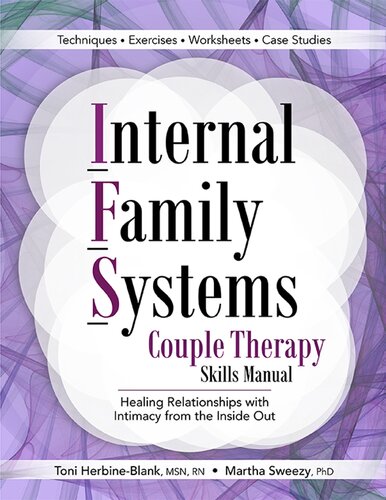This book walks readers through the flow of IFIO descriptively and experientially, weaving interpersonal communication techniques with deep intrapsychic exploration. It guides therapists and couples to intervene effectively in patterns of conflict, move from protective power struggles to vulnerable conversations without attack or silence, and use an essential IFS technique called unblending to understand themselves and others. In the first section, we introduce the conceptual underpinnings of IFIO, including the idea that we all have motivated, active subpersonalities (or parts), who influence our views and behavior, and two easily accessible, crucial skills: (1) differentiating (or unblending) from parts in order to be in relationship with them and (2) attending internally (or doing a U-turn) in order to help parts in moments of reactivity. Additionally, we describe how patterns of autonomic reactivity underlie the compulsive behaviors at the core of a couple’s relational dynamics. In the second section, we provide step-by-step techniques, case examples, and exercises for use with clients in each phase of IFIO treatment. Phase one: We connect with the couple, assesses their relational dynamics, introduce them to IFIO, and start befriending their protective parts. Phase two: We track patterns of conflict and help partners unblend so they can speak for parts and listen from the heart. We aim for the couple to appreciate the inevitability (and acceptability) of differences so they can differentiate from each other comfortably, stay connected, and practice talking in ways that haven’t been possible for a long time, if ever. Phase three: We help them explore the meaning of apology and forgiveness, give them the opportunity to engage in both, and set the stage for them to support each other in healing emotional wounds that predate their relationship. The third section explains how patterns of autonomic reactivity underlie the compulsive behaviors at the core of a couple’s relational dynamics and illustrates how to discuss these phenomena with couples. Finally, the book’s fourth section describes some common challenges for couple therapists, while the fifth section provides additional experiential exercises so partners can rescript and repair conflictual interactions. Because the IFIO approach is best grasped experientially, we recommend that therapists try these exercises personally before using them with clients. Try them with a partner, friend, or colleague. Alternatively, try them in your mind’s eye with your own polarized parts, with someone you know, or with a couple you find manageable
چکیده فارسی
این کتاب خوانندگان را به صورت توصیفی و تجربی در جریان IFIO قرار میدهد و تکنیکهای ارتباط بین فردی را با کاوش عمیق درون روانی در هم میپیوندد. درمانگران و زوجها را راهنمایی میکند تا به طور مؤثر در الگوهای تعارض مداخله کنند، از مبارزات قدرت محافظتی به مکالمات آسیبپذیر بدون حمله یا سکوت حرکت کنند و از یک تکنیک ضروری IFS به نام unblending برای درک خود و دیگران استفاده کنند. در بخش اول، زیربنای مفهومی IFIO را معرفی میکنیم، از جمله این ایده که همه ما دارای زیرشخصیتهای باانگیزه و فعال (یا بخشهایی) هستیم که بر دیدگاهها و رفتار ما تأثیر میگذارند، و دو مهارت حیاتی و قابل دسترسی آسان: (1) تمایز (یا) ترکیب نشدن) از قطعات به منظور ارتباط با آنها و (2) حضور در داخل (یا انجام یک چرخش) به منظور کمک به قطعات در لحظات واکنش. علاوه بر این، ما توضیح میدهیم که چگونه الگوهای واکنشپذیری خودمختار زیربنای رفتارهای اجباری در هسته پویایی رابطه زوجین است. در بخش دوم، تکنیکهای گام به گام، مثالهای موردی و تمرینهایی را برای استفاده با مشتریان در هر مرحله از درمان IFIO ارائه میکنیم. فاز اول: ما با زوج ارتباط برقرار می کنیم، پویایی رابطه آنها را ارزیابی می کنیم، آنها را با IFIO معرفی می کنیم و شروع به دوستی با قسمت های محافظ آنها می کنیم. فاز دوم: الگوهای تعارض را دنبال میکنیم و به شرکا کمک میکنیم تا با هم ترکیب شوند تا بتوانند از صمیم قلب صحبت کنند و گوش دهند. هدف ما این است که زوجین از اجتناب ناپذیر بودن (و مقبولیت) تفاوت ها قدردانی کنند تا بتوانند به راحتی از یکدیگر متمایز شوند، در ارتباط باقی بمانند، و صحبت کردن را به روش هایی تمرین کنند که برای مدت طولانی امکان پذیر نبوده است. مرحله سوم: ما به آنها کمک می کنیم تا معنای عذرخواهی و بخشش را کشف کنند، به آنها فرصت می دهیم تا در هر دوی آنها شرکت کنند و زمینه را برای آنها فراهم می کنیم تا از یکدیگر در التیام زخم های عاطفی که قبل از رابطه آنها ایجاد شده حمایت کنند. بخش سوم توضیح میدهد که چگونه الگوهای واکنشپذیری خودمختار زیربنای رفتارهای اجباری در هسته پویایی رابطه زوجین قرار میگیرد و چگونگی بحث درباره این پدیدهها را با زوجها نشان میدهد. در نهایت، بخش چهارم کتاب برخی از چالشهای رایج برای زوجدرمانگران را تشریح میکند، در حالی که بخش پنجم تمرینهای تجربی بیشتری را ارائه میدهد تا شرکای آن بتوانند تعاملات متضاد را بازنویسی و ترمیم کنند. از آنجایی که رویکرد IFIO به بهترین شکل به صورت تجربی درک میشود، توصیه میکنیم که درمانگران قبل از استفاده از این تمرینها با مشتریان، شخصاً این تمرینها را امتحان کنند. آنها را با یک شریک، دوست یا همکار امتحان کنید. از طرف دیگر، آنها را در ذهن خود با بخش های قطبی شده خود، با کسی که می شناسید یا با زوجی که قابل کنترل می دانید امتحان کنید
ادامه ...
بستن ...
Author(s): Toni Herbine-Blank, Martha Sweezy
Publisher: PESI Publishing, Inc. (23 Mar. 2021), Year: 2021
ISBN: 9781683733676
ادامه ...
بستن ...










